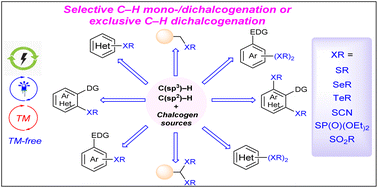Recent advances in selective mono-/dichalcogenation and exclusive dichalcogenation of C(sp2)–H and C(sp3)–H bonds
Abstract
Organochalcogen compounds are prevalent in numerous natural products, pharmaceuticals, agrochemicals, polymers, biological molecules and synthetic intermediates. Direct chalcogenation of C–H bonds has evolved as a step- and atom-economical method for the synthesis of chalcogen-bearing compounds. Nevertheless, direct C–H chalcogenation severely lags behind C–C, C–N and C–O bond formations. Moreover, compared with the C–H monochalcogenation, reports of selective mono-/dichalcogenation and exclusive dichalcogenation of C–H bonds are relatively scarce. The past decade has witnessed significant advancements in selective mono-/dichalcogenation and exclusive dichalcogenation of various C(sp2)–H and C(sp3)–H bonds via transition-metal-catalyzed/mediated, photocatalytic, electrochemical or metal-free approaches. In light of the significance of both mono- and dichalcogen-containing compounds in various fields of chemical science and the critical issue of chemoselectivity in organic synthesis, the present review systematically summarizes the advances in these research fields, with a special focus on elucidating scopes and mechanistic aspects. Moreover, the synthetic limitations, applications of some of these processes, the current challenges and our own perspectives on these highly active research fields are also discussed. Based on the substrate types and C–H bonds being chalcogenated, the present review is organized into four sections: (1) transition-metal-catalyzed/mediated chelation-assisted selective C–H mono-/dichalcogenation or exclusive dichalcogenation of (hetero)arenes; (2) directing group-free selective C–H mono-/dichalcogenation or exclusive dichalcogenation of electron-rich (hetero)arenes; (3) C(sp3)–H dichalcogenation; (4) dichalcogenation of both C(sp2)–H and C(sp3)–H bonds. We believe the present review will serve as an invaluable resource for future innovations and drug discovery.



 Please wait while we load your content...
Please wait while we load your content...